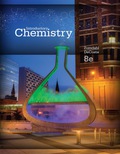
EBK INTRODUCTORY CHEMISTRY
8th Edition
ISBN: 8220100480485
Author: DECOSTE
Publisher: CENGAGE L
expand_more
expand_more
format_list_bulleted
Concept explainers
Textbook Question
Chapter 21, Problem 10QAP
. How many unique amino acid sequences are possible for a tripeptide containing only the amino acids gly, ala, and cys, with each amino acid occurring only once in each molecule?
Expert Solution & Answer
Want to see the full answer?
Check out a sample textbook solution
Students have asked these similar questions
Construct a molecular orbital diagram for carbon monoxide. Identify the relevant point group,include all of the appropriate symmetry labels and pictures, and fill in the electrons. Make sure toaccount for the difference in electronegativity between C and O. Hint: CO is substantiallyisoelectronic to N2. (PLEASE DRAW THE ENTIRE MO DIAGRAM!!!)
please help with hw
help me solve this hw
Chapter 21 Solutions
EBK INTRODUCTORY CHEMISTRY
Ch. 21.9 - Prob. 1CTCh. 21 - Differentiate among primary, secondary, and...Ch. 21 - Prob. 2ALQCh. 21 - Prob. 3ALQCh. 21 - Prob. 4ALQCh. 21 - Prob. 5ALQCh. 21 - Prob. 6ALQCh. 21 - Prob. 7ALQCh. 21 - Prob. 8ALQCh. 21 - Prob. 9ALQ
Ch. 21 - Prob. 10ALQCh. 21 - Prob. 11ALQCh. 21 - Prob. 1QAPCh. 21 - Prob. 2QAPCh. 21 - Prob. 3QAPCh. 21 - Prob. 4QAPCh. 21 - Prob. 5QAPCh. 21 - Prob. 6QAPCh. 21 - Prob. 7QAPCh. 21 - Prob. 8QAPCh. 21 - Prob. 9QAPCh. 21 - . How many unique amino acid sequences are...Ch. 21 - Prob. 11QAPCh. 21 - Prob. 12QAPCh. 21 - Prob. 13QAPCh. 21 - Prob. 14QAPCh. 21 - Prob. 15QAPCh. 21 - Prob. 16QAPCh. 21 - Prob. 17QAPCh. 21 - Prob. 18QAPCh. 21 - Prob. 19QAPCh. 21 - . What protein is responsible for the transport of...Ch. 21 - Prob. 21QAPCh. 21 - Prob. 22QAPCh. 21 - Prob. 23QAPCh. 21 - Prob. 24QAPCh. 21 - . How does the efficiency of an enzyme compare...Ch. 21 - Prob. 26QAPCh. 21 - Prob. 27QAPCh. 21 - . Describe the lock-and-key model for enzymes. Why...Ch. 21 - Prob. 29QAPCh. 21 - Prob. 30QAPCh. 21 - Prob. 31QAPCh. 21 - Prob. 32QAPCh. 21 - Prob. 33QAPCh. 21 - Prob. 34QAPCh. 21 - Prob. 35QAPCh. 21 - Prob. 36QAPCh. 21 - Prob. 37QAPCh. 21 - Prob. 38QAPCh. 21 - Prob. 39QAPCh. 21 - Prob. 40QAPCh. 21 - Prob. 41QAPCh. 21 - Prob. 42QAPCh. 21 - Prob. 43QAPCh. 21 - Prob. 44QAPCh. 21 - Prob. 45QAPCh. 21 - Prob. 46QAPCh. 21 - Prob. 47QAPCh. 21 - Prob. 48QAPCh. 21 - Prob. 49QAPCh. 21 - Prob. 50QAPCh. 21 - . What is a steroid? What basic ring structure 15...Ch. 21 - Prob. 52QAPCh. 21 - Prob. 53QAPCh. 21 - Prob. 54QAPCh. 21 - Prob. 55APCh. 21 - Prob. 56APCh. 21 - Prob. 57APCh. 21 - Prob. 58APCh. 21 - Prob. 59APCh. 21 - Prob. 60APCh. 21 - Prob. 61APCh. 21 - Prob. 62APCh. 21 - Prob. 63APCh. 21 - Prob. 64APCh. 21 - Prob. 65APCh. 21 - Prob. 66APCh. 21 - Prob. 67APCh. 21 - Prob. 68APCh. 21 - Prob. 69APCh. 21 - Prob. 70APCh. 21 - Prob. 71APCh. 21 - Prob. 72APCh. 21 - Prob. 73APCh. 21 - Prob. 74APCh. 21 - Prob. 75APCh. 21 - Prob. 76APCh. 21 - Prob. 77APCh. 21 - Prob. 78APCh. 21 - Prob. 79APCh. 21 - Prob. 80APCh. 21 - Prob. 81APCh. 21 - Prob. 82APCh. 21 - Prob. 83APCh. 21 - Prob. 84APCh. 21 - Prob. 85APCh. 21 - Prob. 86APCh. 21 - Prob. 87APCh. 21 - Prob. 88APCh. 21 - Prob. 89APCh. 21 - Prob. 90APCh. 21 - Prob. 91APCh. 21 - Prob. 92APCh. 21 - Prob. 93APCh. 21 - Prob. 94APCh. 21 - Prob. 95APCh. 21 - Prob. 96APCh. 21 - . How many possible primary structures exist for a...Ch. 21 - Prob. 98APCh. 21 - Prob. 99APCh. 21 - Prob. 100APCh. 21 - Prob. 101APCh. 21 - Prob. 102APCh. 21 - Prob. 103APCh. 21 - Prob. 104APCh. 21 - Prob. 105APCh. 21 - Prob. 106AP
Knowledge Booster
Learn more about
Need a deep-dive on the concept behind this application? Look no further. Learn more about this topic, chemistry and related others by exploring similar questions and additional content below.Similar questions
- Briefly explain chemical potential.arrow_forwardReason whether it is possible to determine changes in the Galvani potential difference at the metal-solution interface.arrow_forwardObtain the standard potential at 25°C of the Cu* I Cu | Pt electrode from the standard potentials E° Cu²+/Cu = 0.341 V and E Cu²+ /Cu+ = 0.153 V.arrow_forward
arrow_back_ios
SEE MORE QUESTIONS
arrow_forward_ios
Recommended textbooks for you
 World of Chemistry, 3rd editionChemistryISBN:9781133109655Author:Steven S. Zumdahl, Susan L. Zumdahl, Donald J. DeCostePublisher:Brooks / Cole / Cengage Learning
World of Chemistry, 3rd editionChemistryISBN:9781133109655Author:Steven S. Zumdahl, Susan L. Zumdahl, Donald J. DeCostePublisher:Brooks / Cole / Cengage Learning Introductory Chemistry: A FoundationChemistryISBN:9781337399425Author:Steven S. Zumdahl, Donald J. DeCostePublisher:Cengage Learning
Introductory Chemistry: A FoundationChemistryISBN:9781337399425Author:Steven S. Zumdahl, Donald J. DeCostePublisher:Cengage Learning General, Organic, and Biological ChemistryChemistryISBN:9781285853918Author:H. Stephen StokerPublisher:Cengage Learning
General, Organic, and Biological ChemistryChemistryISBN:9781285853918Author:H. Stephen StokerPublisher:Cengage Learning Organic And Biological ChemistryChemistryISBN:9781305081079Author:STOKER, H. Stephen (howard Stephen)Publisher:Cengage Learning,
Organic And Biological ChemistryChemistryISBN:9781305081079Author:STOKER, H. Stephen (howard Stephen)Publisher:Cengage Learning, World of ChemistryChemistryISBN:9780618562763Author:Steven S. ZumdahlPublisher:Houghton Mifflin College Div
World of ChemistryChemistryISBN:9780618562763Author:Steven S. ZumdahlPublisher:Houghton Mifflin College Div Chemistry for Today: General, Organic, and Bioche...ChemistryISBN:9781305960060Author:Spencer L. Seager, Michael R. Slabaugh, Maren S. HansenPublisher:Cengage Learning
Chemistry for Today: General, Organic, and Bioche...ChemistryISBN:9781305960060Author:Spencer L. Seager, Michael R. Slabaugh, Maren S. HansenPublisher:Cengage Learning

World of Chemistry, 3rd edition
Chemistry
ISBN:9781133109655
Author:Steven S. Zumdahl, Susan L. Zumdahl, Donald J. DeCoste
Publisher:Brooks / Cole / Cengage Learning

Introductory Chemistry: A Foundation
Chemistry
ISBN:9781337399425
Author:Steven S. Zumdahl, Donald J. DeCoste
Publisher:Cengage Learning

General, Organic, and Biological Chemistry
Chemistry
ISBN:9781285853918
Author:H. Stephen Stoker
Publisher:Cengage Learning

Organic And Biological Chemistry
Chemistry
ISBN:9781305081079
Author:STOKER, H. Stephen (howard Stephen)
Publisher:Cengage Learning,

World of Chemistry
Chemistry
ISBN:9780618562763
Author:Steven S. Zumdahl
Publisher:Houghton Mifflin College Div

Chemistry for Today: General, Organic, and Bioche...
Chemistry
ISBN:9781305960060
Author:Spencer L. Seager, Michael R. Slabaugh, Maren S. Hansen
Publisher:Cengage Learning
Biomolecules - Protein - Amino acids; Author: Tutorials Point (India) Ltd.;https://www.youtube.com/watch?v=ySNVPDHJ0ek;License: Standard YouTube License, CC-BY